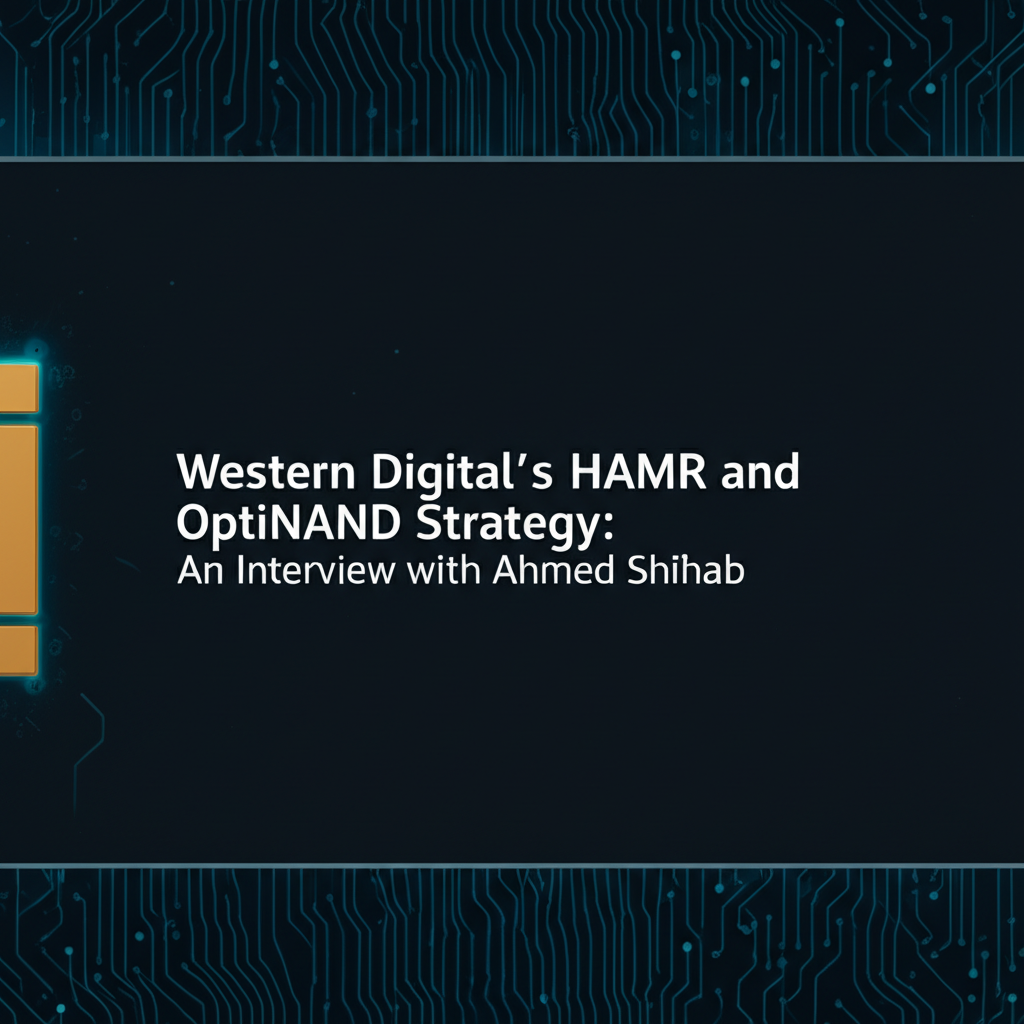Western Digital's Strategic Vision: HAMR, OptiNAND, and the Future of HDDs
In the ever-evolving landscape of data storage, hard disk drives (HDDs) continue to play a foundational role, particularly in the massive data centers operated by hyperscale cloud providers. As data creation accelerates, the demand for higher capacity drives intensifies, pushing manufacturers to explore and implement advanced recording technologies. Heat-Assisted Magnetic Recording (HAMR) is one such technology poised to significantly increase areal density and, consequently, drive capacity.
Western Digital, a key player in the HDD market, is actively developing its HAMR technology. To gain insight into their progress and strategic direction, we recently had the opportunity to speak with Ahmed Shihab, Western Digital's chief product and engineering officer. Shihab, who joined WD after significant roles at Microsoft Azure and AWS, brings a unique hyperscaler perspective to the company's storage roadmap. His insights shed light on WD's HAMR development, the advantages of their unique OptiNAND technology, and their view on the future of HDDs in various applications.
The State of HAMR at Western Digital
The transition to HAMR is a complex undertaking, involving significant advancements in media, heads, and manufacturing processes. Seagate, a competitor, has been navigating its own HAMR journey, which has included a multi-year qualification process with customers. Western Digital, while following Seagate into the HAMR era, aims to leverage lessons learned and its own technological strengths to ensure a smoother transition.
Shihab shared positive news regarding WD's internal HAMR development. "Actually, I was a little afraid when I first came in. It’s like, what will I find? But I was really happy with what I found because actually HAMR technology works. That’s the good news," he stated. While the fundamental physics and core recording technologies (media, heads) are proven, significant engineering and manufacturing work remains to achieve the desired reliability and density levels for mass production.
A crucial aspect of WD's strategy is early engagement with key customers, particularly hyperscalers. Shihab, drawing from his background at major cloud providers, understands the lengthy and rigorous qualification processes involved. "One of the lessons we learned is engage your customers early... It takes a long time to qualify," he explained. By involving customers early, WD can gather feedback and align development with real-world requirements, aiming to avoid the protracted qualification challenges faced by others.
This 'fast follow' approach, as Shihab described, drawing parallels to AWS's historical strategy, allows WD to benefit from the experiences and feedback already generated in the market. Customers are already providing feedback on early drives, which is helping to accelerate the development and refinement process.
Leveraging the 11-Platter Design and OptiNAND
Western Digital's current high-capacity drives utilize an 11-platter design, which Shihab believes provides a distinct advantage as they transition to HAMR. While Seagate has focused on 10-platter designs, WD's extra platter offers more headroom. "It certainly gives us more headroom to play with. We can use the extra platter to give us the overall capacity at lower density," Shihab noted. This means WD might be able to reach specific capacity points with slightly less aggressive areal density requirements per platter compared to a 10-platter design, potentially facilitating a faster time to market.
Operating with 11 platters is technically challenging, requiring extremely tight tolerances for mechanics and vibrations, but WD has experience with this configuration in their current ePMR drives.
Another significant differentiator for Western Digital is its OptiNAND technology. OptiNAND integrates NAND flash onto the HDD platform, primarily used to store metadata and manage shingled magnetic recording (SMR) operations more efficiently. This technology enables UltraSMR, an algorithmic technique that increases capacity per platter by optimizing how data is written to overlapping tracks.
Shihab emphasized the synergy between OptiNAND/UltraSMR and HAMR. "UltraSMR (shingling) is what really is enabled by OptiNAND and UltraSMR is an algorithmic gain of capacity... We expect it to apply equally to HAMR," he stated. Because OptiNAND and UltraSMR are already implemented and qualified in WD's ePMR drives, customers transitioning to HAMR drives that incorporate these technologies will not need to develop new software for the shingling aspects. This reduces friction and simplifies adoption.
The combination of the 11-platter design and the capacity gains from OptiNAND/UltraSMR provides WD with flexibility and headroom in their HAMR roadmap. While they may initially be conservative with capacity points, Shihab is confident that these technologies position WD to match and exceed competitor capacities while maintaining their reputation for reliability.
"We’re going to match and exceed Seagate’s capacity because we can win with things like OptiNAND that all our customers have qualified... They have qualified UltraSMR on ePMR. That’s already qualified in their software and we don’t have to do anything different when they come to the new drives with HAMR in them," Shihab explained.

The Enduring Role of HDDs in the Data Economy
Despite the rise of Solid State Drives (SSDs), Shihab firmly believes that HDDs remain the "bedrock of all the data economy." He highlighted the nature of data in hyperscale environments, where massive amounts of data are constantly moving between tiers, regions, and undergoing background processes like scrubbing and bit rot checking. This active environment, handling large objects and chunks of data, plays to the strengths of HDDs.
For these workloads, Shihab argued that "performance per terabyte is actually really more important than the IOPS." HDDs offer the necessary read/write endurance and bandwidth for these large-scale, sequential access patterns, and critically, they do so at a significantly lower cost per terabyte compared to SSDs.
He cited cloud object stores (like AWS S3 and Azure Blob Storage) as prime examples where HDDs are essential. The sheer volume of data and the need for cost-effective, high-capacity storage make HDDs the ideal choice for the lower tiers of cloud storage.
Beyond the cloud, Shihab pointed to video surveillance as another key application where HDDs excel. Video surveillance workloads are characterized by continuous, write-intensive streams. The high endurance and cost-effectiveness of HDDs make them a perfect fit for storing vast amounts of video data over long periods. Shihab contrasted this with QLC NAND, noting that HDDs are "6x cheaper than QLC NAND and having practically infinite endurance," making them superior for such write-heavy, cost-sensitive use cases.
SSDs, while crucial for performance-sensitive applications, are better suited for small block-based use cases, caching, and high-intensity random read workloads. Shihab views the relationship between HDDs and SSDs as complementary – "better together than one versus the other."
Form Factor, Future Innovations, and Interfaces
The 3.5-inch, 1-inch high form factor has been the standard for enterprise HDDs for decades, and Shihab sees this continuing. While other form factors like 5.25-inch have been explored, the existing infrastructure, operational familiarity, and the physical constraints related to platter size, spin rate, and mechanics have solidified the 3.5-inch drive's position. "It’s here to stay in my opinion," he stated.
Looking ahead, Shihab is optimistic about the long-term potential of HAMR. He believes the technology has a roadmap that can sustain density increases for another 10 to 20 years, continuing to deliver the desired dollars per terabyte for customers.
Intriguingly, Shihab also teased a new capability WD is developing to address performance: increasing the bandwidth per terabyte. While he didn't provide details, he mentioned it publicly, indicating it's a significant area of focus and excitement for the company. This suggests WD is not only focused on capacity but also on improving the rate at which data can be accessed from high-density drives, a critical factor for hyperscale workloads.
Regarding drive interfaces, the conversation touched upon the potential future of NVMe access for HDDs. Currently, enterprise HDDs primarily use SATA and SAS interfaces. NVMe is prevalent in high-performance SSDs due to its ability to leverage the speed of flash memory and PCIe connections.
Shihab's perspective on NVMe for HDDs is rooted in pragmatism. He believes NVMe will become important for HDDs only when the bandwidth requirements exceed the capabilities of current interfaces like SATA. "If there’s no need for it, don’t do it, because it’s disruptive to customers," he advised. WD prioritizes reducing friction for customers adopting new technology, a lesson learned partly from the implementation of SMR.
The company has actively worked with customers, providing code and libraries to help them integrate new drive technologies smoothly. Changing the interface is technically feasible ("Doing NVMe now is not really hard. It’s changing the wire and the protocol. It’s not a big deal"), but the key question is market readiness and necessity. Customers will only make the transition when the performance benefits of NVMe become essential for their HDD workloads.
Key Takeaways from the Interview
The discussion with Ahmed Shihab highlights several key aspects of Western Digital's storage strategy and the broader HDD market:
- HAMR Progress: WD's HAMR technology is functional, with the core physics and recording elements in place. The focus is now on engineering and manufacturing refinement to achieve reliability and density targets.
- Early Customer Engagement: Leveraging Shihab's hyperscaler experience, WD is prioritizing early collaboration with customers to smooth the HAMR qualification process and learn from market experience.
- Capacity Advantage: The combination of an 11-platter design and OptiNAND-enabled UltraSMR provides WD with significant headroom and flexibility to deliver competitive, high-capacity HAMR drives.
- OptiNAND's Role: OptiNAND is crucial for enabling UltraSMR's algorithmic capacity gains and simplifies the transition for customers already qualified on ePMR drives.
- HDD Relevance: HDDs remain vital for the data economy, particularly for cost-sensitive, high-capacity applications like cloud object storage and video surveillance, where performance per terabyte and endurance are key.
- Long-Term Roadmap: HAMR is expected to provide density growth for many years, and WD is exploring innovations to improve bandwidth per terabyte.
- Pragmatic Interface Approach: WD will consider NVMe for HDDs when customer needs and bandwidth requirements necessitate the transition, prioritizing minimal disruption.
Western Digital appears confident in its technological path forward, leveraging its existing strengths in multi-platter designs and OptiNAND while diligently working to bring HAMR to market. The insights from Ahmed Shihab underscore the strategic importance of HDDs for the massive data storage needs of the future and WD's focused approach to meeting those demands.
For more context on related topics, you can explore:
- Seagate's HAMR drive development and qualification challenges
- Western Digital's ePMR technology and high-capacity drives
- Background on WD's OptiNAND and MAMR development
- Details on Shingled Magnetic Recording (SMR) and caching zones

